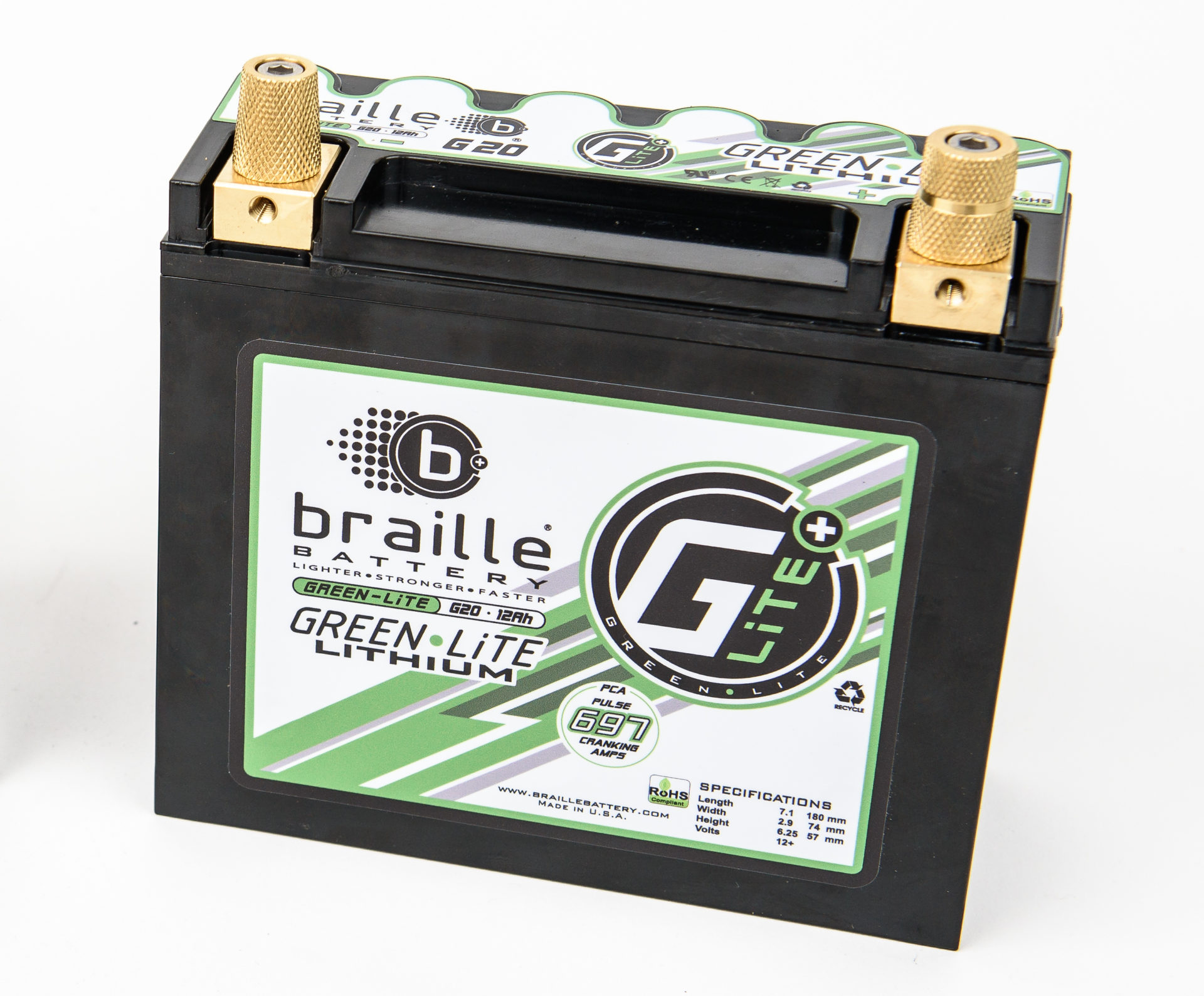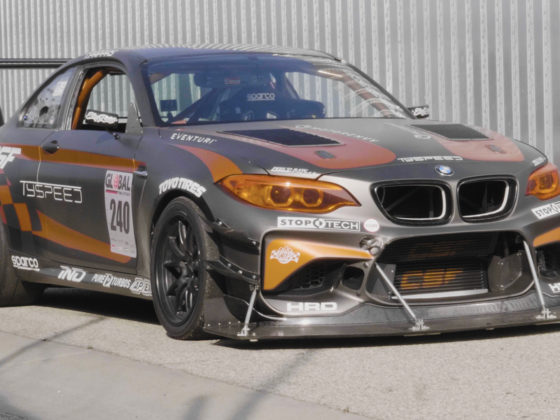
Project Evo IX had a dead battery. Our car had been in storage for a couple of years which killed the lightweight Braille Battery AGM battery we had installed in the car years ago. Our old discontinued Braille Gell Cell lead-acid battery was as dead as a door nail from sitting for years. It weighed just under 12 lbs. This was a good decrease from our stock battery which weighed 41 lbs. This battery worked exceedingly well, perhaps its only drawback was its 14 amp-hour capacity which caused the car’s dark current draw to drain it in about 3 weeks of sitting unless it had a battery tender on it which was no big deal. However, at some point in storage, I removed the battery tender for the car and it sat for a long time with no charger at all. Completely discharging a conventional battery and letting it sit for a long time is the worst thing you can do to a conventional battery.

We called our friends over at Braille to get a replacement. We figured getting a replacement from Braille would be the easiest solution since we had previously installed one of their battery mounts in the trunk of the Evo for . Here is our new Braille Lithium battery on the right vs our old discontinued AGM battery on the left.
The notch on top of the batteries is used for the Braille battery mount, which will work on the old battery and new battery. This means our existing Braille mount can be easily modified to fit and we can enjoy all the performance benefits of Braille’s new Lithium battery technology. Although the new battery is bigger, it is much lighter!

Our poor dead AGM Braille Battery weighed in at 11.95 lbs on our scale. This still saved a lot of weight over the 41 lb stock battery. We had also moved the battery from the front of the car to the back trunk which changed the car’s weight distribution by a whole percentage point, this was a huge difference.

We replaced the old AGM battery with something that would take advantage of the improvements in car battery technology over the years. We selected a Braille Green Lite G20 battery which uses lithium chemistry. The G20 only weighs 5.8 lbs (Braille claims 4.5 lbs but heck at this weight who cares!) It has 697 cranking amps and a capacity of 36 amp-hours. It can also withstand 5,000 charge cycles. Braille rates the G20 as appropriate for 4-6 cylinder engines and even high compression race engines. This is a significantly better performance than our old battery at half the weight! It is mind-blowing that this tiny, super lightweight battery can have so much power!
Our old battery had about the equivalent performance to the very popular classic race car battery, the Odyssey PC680. The PC680 weighs 15.4 lbs, has 520 cranking amps, 16 amp-hours of capacity and has a 400 cycle life. The Braille G20 blows it out of the water and is almost 3x lighter!

The Braille battery has a lot of flexibility in mounting via the terminal connection. You can do a post or an eyelet terminal configuration as well as a top or side mount or any combination of the two. Here is what the post adaptor looks like. You can put it into either hole in the terminal block. We used eyelet terminals for our application.




14 comments
I love the idea of putting a lightweight battery in a sports car but the NA miata uses the battery, spare wheel and jack as counterweight on the rear right corner, and with a 220 pound 6’2 canadian driving like a dickhead it needs all the balance it can get.
Maybe I could remove the power steering and change the battery at the same time.
Well in my opinion excess mass is never a good thing. In the case of the NA, it’s not there to balance the car but since it has to be there, lets put it in the least harmful for balance location. A long time ago we did an article on how battery location affects corner weights. You might want to check it out!
https://motoiq.com/the-hows-and-whys-of-battery-relocation-how-battery-relocation-affects-corner-weight/
I read that article way back when I worked at Mooresport.
Claude Rouelle from Optimum G was chatting about FSAE cars and how students often would get faster by adding weights to balance out the corners even in the acceleration events,
I guess that stuck in my mind.
I never checked the corner weights on the miata anyways, I just noticed that it’s more stable in hard right turns with someone in the passenger seat.
Does Daniel O’Donnell’s project miata still have the stock battery, he probably has a better idea than me about the balance difference?
I don’t believe in adding mass EVER unless the car is too light and you need to ballast for rules compliance. Then you put it in smart places. Usually, a bespoke car like an FSAE racer can be designed with good corner weights!
How does this compare to the antigravity battery used in the Cayman?
The Cayman battery has the restart feature and is bigger, heavier with more capacity, not a direct comparison.
All I can say is keep a close eye on this. I had this exact battery and charger combo and the battery exploded while the charger was connected to it. Luckily it didn’t cause too much damage but a couple inches in one direction and it would have destroyed several thousand $ in Motec electronics. The worst part was I couldn’t get Braille to respond to me when I tried to bring it to their attention (multiple times). I switched to Antigravity and it’s been much more reliable.
Was your battery close to fully discharged? Was the car running and on the charger at the same time?
The car wasn’t running, it happened overnight while it was sitting in the shop. It had just started the car a couple days prior so I highly doubt it was almost fully discharged. Before the charger was hooked up, it didn’t have enough charge to start the engine over but it would power up the electronics. I know lithium batteries can be finicky and this isn’t super uncommon, I’m mostly disappointed in their total lack of response.
Sounds like you a bad cell if the car was dead after only a few days. I’ve seen it too many times in R/C racing, especially with cheap battery packs. If one cell goes bad it’ll drain the entire pack and act like a giant resistor. When you recharge it, it overheats. A good battery will have a vent designed specifically to relieve any pressure buildup and prevent a catastrophic explosion.
I’ve always been wary of Li-Po batteries in street cars due to the messes I’ve seen in R/C racing. I’m planning to use an Li-Fe battery for the Cappuccino in the near future to prevent a lot of the charge/discharge concerns of a Li-Po. The Cappuccino’s battery is so small the weight penalty is only a pound or so, so it’s well worth it to go with the slightly heavier, safer option for a car that sits a lot.
More than a few days, like two to three weeks.
Very clean install, working on the same thing with my car now. What gauge wire did you use for the positive terminal?
OO
I didn’t know that old batteries were heavier. I need to get a new battery for my car. I’ll have to consider getting a battery that can last at least 5 years.